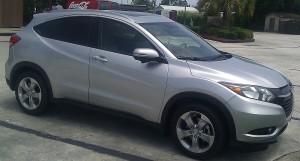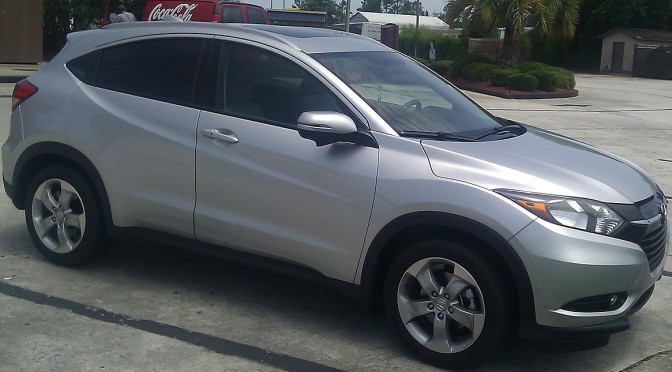The Honda HR-V is a mini SUV recently brought to the US market to compete with other subcompact and compact crossovers like the Chevrolet Trax / Buick Encore, the HR-V’s larger brand sibling Honda CR-V, Toyota RAV4, Nissan Rogue, Mazda CX-5, Subaru Forester, Ford Escape, Jeep Compass, Kia Sportage, Hyundai Tuscon, Jeep Renegade, and Jeep Patriot. The market is crowded, but it’s a popular one among small families interested in fuel economy, maneuverability, and hatchback practicality.
I got a hold of an HR-V and liked what I saw. Based on the similarly-sized Fit, it looks small on the outside but is surprisingly roomy on the inside, and comes with the latest safety features we’ve come to expect in new vehicles in the US, like good crash scores, ESC, and side impact airbags. However, what most interested me was whether I’d be able to stuff 3 car seats into the back row without spending half the afternoon scraping my knuckles. Is it possible? Read on to find out!
Before we dive into which seats did and didn’t work in the HR-V, though, why not join me for a quick read of what’s important to do and when (and why!) when it comes to car seat ages and stages.
For me, car seat safety starts with rear-facing. It’s the safest position we know of, and the longer our kids rear-face, the safer they’ll be, regardless of what kind of vehicle they travel in. I recommend keeping children in rear-facing infant or convertible seats as long as possible (ideally until 4!), then keeping them harnessed in forward-facing seats for several years more (ideally until 8!), and then only switching them out of booster seats when they pass the 5 step test (which typically happens between 10 and 12). The goal is to keep kids in the safest kinds of seats for as long as possible to increase their odds of surviving serious car crashes.
With that all in mind, I got to work with my seats to create what I believe to be the most detailed 3 across guide for the Honda HR-V on the Internet. If you find the list helpful when shopping for car seats, you can shop through my Amazon link below. I’ll add more seats as I test them over time.
You can access the complete 3 across guide for every vehicle here and the complete list of recommended seats here. The Canadian car seat guide is here. 3 across car seat images are taken by yours truly or are courtesy of Wikipedia.
 2016, 2017 Honda HR-V (2nd gen, 1st US gen)
2016, 2017 Honda HR-V (2nd gen, 1st US gen)
Guaranteed 3 across installations:
Clek Fllo (x3).
Clek Foonf (x3).
Diono Radian RXT (x3).
Diono Radian R120 (x3).
Diono Radian R100 (x3).
Chicco KeyFit 30 (x3).
Tips and Tricks:
The initial US generation of the HR-V is just over 169 inches long and just under 70 inches wide. In other words, it’s a very short and very narrow SUV. The width hurts you when it comes to 3 across installations while the length makes it difficult to fit rear-facing seats without robbing precious leg room from front row occupants. This is one of the most difficult vehicles I’ve successfully worked with when it comes to 3 across installations; to be honest, I found the Fit slightly more friendly, even though they’re based on the same platform and the Fit is narrower.
You can get around the leg room issue with my rear-facing convertible leg room comparison guide, and you can get around the width issue by using the seats I listed above. You’ll absolutely want to use the seat belts instead of the LATCH system, as the LATCH anchors are spaced wide apart, which keeps you from making the most of your very limited back seat room. If you’ve only got one or two seats to install at a time, however, feel free to use the LATCH system.
—
If you find the information on car safety, recommended car seats, and car seat reviews on this car seat blog helpful, you can shop through this Amazon link for any purchases, car seat-related or not. Canadians can shop through this link for Canadian purchases.


